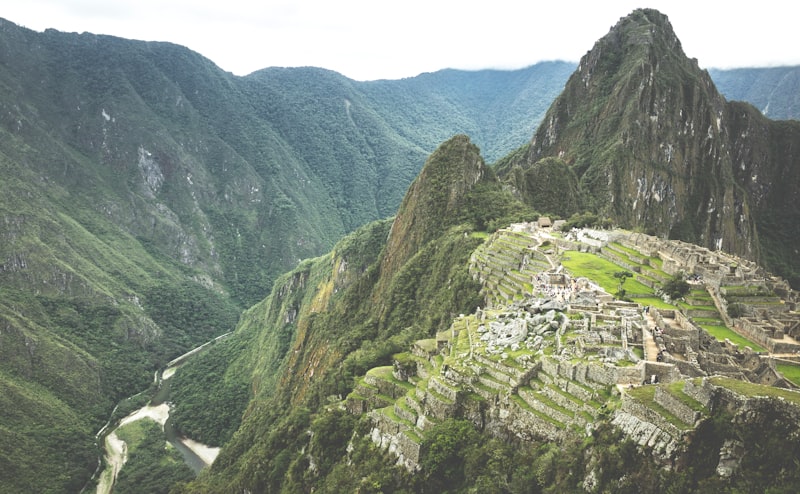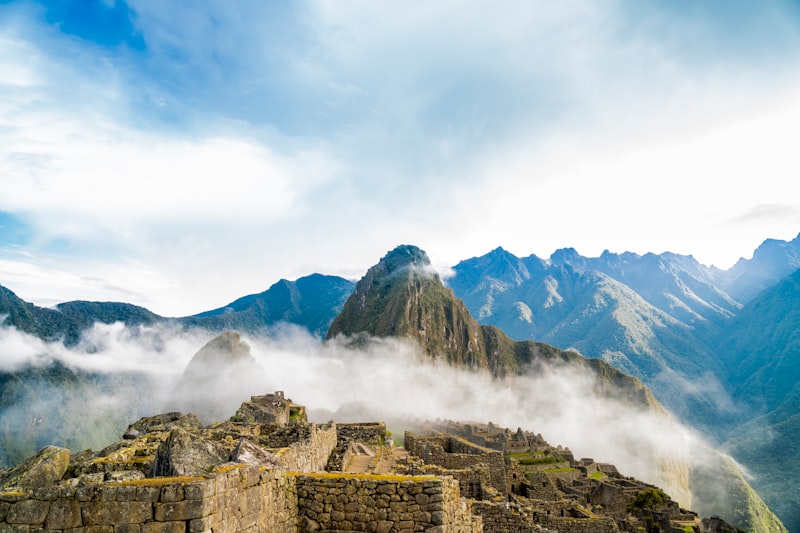
Nestled high in the Andes Mountains of Peru, the ancient ruins of Machu Picchu stand as a testament to the ingenuity and architectural prowess of the Inca civilization. Perched atop a ridge overlooking the Urubamba River, this UNESCO World Heritage site draws visitors from around the globe, all eager to unravel its mysteries.

Imagine standing amidst the mist that shrouds Machu Picchu in the early morning, the sun slowly illuminating the stone structures that have endured for centuries. The city is divided into two main areas: the agricultural sector, featuring terraced fields that once fed its inhabitants, and the urban sector, where temples, plazas, and residential quarters intertwine in a labyrinth of stone.
One of the most iconic features is Inti Watana, the Hitching Post of the Sun, a carved stone pillar believed to have been used for astronomical observations and rituals. The precision with which it aligns with the sun during solstices speaks volumes about the Inca’s astronomical knowledge.
As you wander through the site, you can’t help but marvel at how the Inca managed to construct such a complex city on steep, mountainous terrain without the use of wheels or iron tools. Every stone in Machu Picchu fits seamlessly with its neighbors, a testament to their masonry skills and engineering acumen.
What makes Machu Picchu even more intriguing is the mystery surrounding its abandonment. Scholars believe it was built around 1450 AD and deserted less than a century later, possibly due to political upheaval or the arrival of Spanish conquistadors. Yet, its rediscovery in 1911 by Hiram Bingham sparked renewed interest in Inca culture and history.
Unveiling the Mysteries: Exploring the Ancient Ruins of Machu Picchu
Perched on a ridge above the Urubamba River, Machu Picchu was built by the Inca Empire in the 15th century. Its precise construction without mortar, using carefully cut stones that fit together perfectly, showcases the advanced architectural prowess of its builders. The site is divided into two main areas: the agricultural sector, with terraces that once sustained the population, and the urban sector, featuring temples, plazas, and residential buildings.
Visitors to Machu Picchu are greeted by the iconic Intihuatana stone, believed to have served as an astronomical observatory or a ritualistic device. This sacred stone, along with the Temple of the Sun and the Room of the Three Windows, highlights the Inca’s deep connection to celestial events and their spiritual beliefs.
Theories abound about the purpose of Machu Picchu. Some scholars suggest it was a royal estate or a spiritual retreat, while others believe it held strategic military significance. Regardless of its exact purpose, Machu Picchu stands as a testament to the ingenuity of its creators and the mysteries of its abandonment around the time of the Spanish Conquest.
Today, Machu Picchu is a UNESCO World Heritage site and one of the New Seven Wonders of the World, attracting travelers and historians alike from across the globe. Its remote location and stunning vistas offer a glimpse into the ancient Andean civilization, inviting visitors to ponder its secrets and marvel at its enduring beauty.
Lost City of the Incas: A Journey through Machu Picchu’s Secrets
Perched high above the Sacred Valley, Machu Picchu’s allure lies not just in its architectural marvels but in its enigmatic history. Imagine standing amidst the ruins of temples, terraces, and residential areas that whisper tales of a bygone era. Each stone, meticulously carved and fitted without mortar, tells a story of advanced engineering and artistic finesse of the Incas.

The journey to Machu Picchu is not merely a physical one but a spiritual odyssey through time. As you traverse the rugged mountain trails, surrounded by mist-laden peaks and lush greenery, you can’t help but wonder about the lives of those who once thrived here. What mysteries did they ponder under the starry skies? How did they channel the natural elements to build a city that defied the odds?
Visitors often find themselves captivated by Intihuatana, the Hitching Post of the Sun, a stone structure believed to have served astronomical and ceremonial purposes. It symbolizes the Incas’ deep connection with the cosmos and their profound knowledge of celestial movements.
Moreover, the agricultural terraces of Machu Picchu are a testament to the Inca’s ingenuity in cultivating crops at such high altitudes, sustaining a thriving community in harmony with their environment.
In essence, Machu Picchu is more than just a historical site; it’s a living testament to the resilience and creativity of a civilization lost to time. Whether you’re a history enthusiast, an adventurer seeking new horizons, or simply someone in awe of nature’s wonders, Machu Picchu promises an experience that transcends words—a journey into the heart of ancient Andean culture.
Beyond the Clouds: Discovering Machu Picchu’s Historic Marvels
Imagine trekking through lush, emerald-green forests, the air crisp with the scent of wild orchids and the distant melody of exotic birds. As you ascend through rugged terrain, the anticipation builds. Suddenly, emerging from the swirling clouds, Machu Picchu reveals itself in all its splendor. The first glimpse of these centuries-old stone citadels, terraced fields cascading down steep slopes, and enigmatic temples leaves visitors spellbound.
What makes Machu Picchu truly extraordinary is its mysterious history. Believed to have been constructed in the 15th century under the command of Incan emperor Pachacuti, its exact purpose remains shrouded in mystery. Some believe it served as a royal estate or a religious sanctuary, while others speculate it was a strategic military outpost. The site’s precise alignment with celestial events suggests it may have also functioned as an astronomical observatory, highlighting the advanced knowledge of its builders.
Walking through Machu Picchu’s labyrinthine corridors and expansive plazas, one can’t help but marvel at the precision of its construction. Each stone meticulously cut and placed without mortar, fitting together like a giant 3D puzzle. This architectural feat not only withstands the test of time but also speaks volumes about the Incas’ engineering expertise and cultural sophistication.
Beyond its structural brilliance, Machu Picchu offers visitors a spiritual journey. The aura of tranquility that permeates the site, coupled with panoramic views of the surrounding peaks and the Urubamba River below, creates an almost surreal experience. It’s a place where one can ponder the mysteries of the past while feeling connected to the natural world.
Timeless Wonder: The Enigmatic Beauty of Machu Picchu Revealed
Perched atop a ridge overlooking the Urubamba River valley, Machu Picchu’s precise layout and structural design are marvels of engineering. The Incas, without the aid of modern technology, crafted this citadel using precisely cut stones that fit together seamlessly, a feat that still baffles archaeologists today. Walking through its labyrinthine paths, one can’t help but marvel at the strategic placement of temples, terraces, and plazas amidst the breathtaking backdrop of mist-shrouded mountains.
The allure of Machu Picchu goes beyond its physical attributes; it embodies a spiritual and cultural significance for the Quechua people and serves as a symbol of their resilience and heritage. This UNESCO World Heritage site offers a glimpse into the sophisticated urban planning and astronomical knowledge of the Incan civilization, evident in structures like the Intihuatana stone, believed to have served as a solar clock.
For adventurers and history enthusiasts alike, Machu Picchu beckons as a pilgrimage site—one where the journey to reach it is as transformative as the destination itself. Whether trekking along the famed Inca Trail or arriving by train through the Sacred Valley, every approach unveils new perspectives of this archaeological marvel.
In popular culture, Machu Picchu has become synonymous with awe-inspiring beauty and mystery, attracting curious minds eager to uncover its secrets. Its designation as one of the New Seven Wonders of the World further underscores its global significance and enduring appeal.
In essence, Machu Picchu is more than just a historical site; it’s a living testament to the ingenuity and cultural richness of the Incan civilization. As visitors stand amidst its ancient stone walls, they can’t help but feel a profound connection to the past and a sense of wonder that transcends time itself.
Inca Heritage: Tracing the Legacy of Machu Picchu’s Ancient Civilization
Nestled high in the Peruvian Andes, Machu Picchu stands as a testament to the remarkable legacy of the Inca civilization. This ancient citadel, shrouded in mist and mystery, continues to captivate the imagination of travelers and historians alike. Built in the 15th century under the reign of Inca emperor Pachacuti, Machu Picchu served as a royal estate and religious sanctuary, tucked away amidst the breathtaking peaks of the Andes Mountains.
The architectural marvels of Machu Picchu are a testament to the ingenuity of the Inca people. The precision with which they cut and fitted the massive stone blocks without mortar continues to baffle experts today. Each structure within the citadel was meticulously crafted to harmonize with the natural landscape, creating a symbiotic relationship between human endeavor and the environment.
Beyond its architectural splendor, Machu Picchu holds profound cultural significance. It served not only as a retreat for Inca royalty but also as a center of spiritual worship and astronomical observation. The site’s strategic location, nestled between two mountain peaks, is believed to have held ceremonial importance, aligning with the solstices and equinoxes.
Exploring Machu Picchu today offers visitors a glimpse into the rich tapestry of Inca life and society. The terraced fields, where crops like maize and potatoes once thrived, reflect the Inca’s mastery of agricultural techniques adapted to the challenging mountain terrain. The intricate network of stone pathways, staircases, and water channels reveals their advanced understanding of engineering and urban planning.
As we trace the legacy of Machu Picchu’s ancient civilization, we are reminded of the enduring spirit of innovation and harmony with nature that defined the Inca culture. Each stone tells a story of resilience, craftsmanship, and reverence for the natural world. Machu Picchu stands not only as a UNESCO World Heritage site but also as a timeless symbol of human achievement and the enduring legacy of the Inca civilization.
This article aims to engage readers with its captivating narrative style while maintaining a focus on the SEO keyword “Inca Heritage: Tracing the Legacy of Machu Picchu’s Ancient Civilization.”
A Pinnacle of Human Ingenuity: Machu Picchu’s Architectural Marvels
The architectural marvels of Machu Picchu are a blend of sophisticated engineering and cultural significance. The Incas, known for their advanced knowledge of stonework and astronomy, designed Machu Picchu with meticulous detail. The site is divided into two main areas: the agricultural sector, featuring terraced fields that allowed for cultivation at such high altitudes, and the urban sector, comprised of temples, palaces, and residential buildings.
One of the most striking features of Machu Picchu is its stone structures, meticulously cut and fitted together without mortar. The precision of Inca masonry is evident in the seamless joints between stones, so precise that not even a blade of grass can fit between them. This technique, known as ashlar masonry, showcases the Inca’s engineering prowess and their ability to construct earthquake-resistant buildings.
Walking through Machu Picchu, visitors can marvel at the Temple of the Sun, an elliptically-shaped structure dedicated to Inti, the Incan sun god. Its walls are angled precisely to capture the sun’s rays during the winter and summer solstices, demonstrating the Inca’s deep understanding of astronomy and their reverence for celestial bodies.
The Sacred Plaza, at the heart of Machu Picchu, served as a ceremonial space where rituals and festivities were held. Surrounding it are temples and royal residences, showcasing the hierarchical structure of Incan society and their spiritual beliefs.
Machu Picchu’s location amidst lush green mountains and its integration with the surrounding natural landscape reflect the Inca’s harmonious relationship with nature. The site’s strategic positioning not only provided natural defenses but also offered breathtaking panoramic views of the Andes, emphasizing the spiritual connection between the Incas and their environment.
In summary, Machu Picchu is more than just an archaeological site; it is a testament to the ingenuity, cultural richness, and spiritual depth of the Inca civilization. Each stone, each terrace, and each structure tells a story of innovation and reverence, inviting visitors to ponder the mysteries of this ancient wonder.
Frequently Asked Questions
Are there guided tours available at Machu Picchu?
Yes, guided tours are available at Machu Picchu. These tours are led by knowledgeable guides who provide insights into the history, architecture, and significance of the site, enhancing visitors’ experiences.
What should I wear when visiting Machu Picchu?
Discover essential tips on dressing comfortably and appropriately for your visit to Machu Picchu, ensuring you’re prepared for the weather conditions and hiking activities at this iconic archaeological site.
What is Machu Picchu and why is it famous?
Machu Picchu is an ancient Incan citadel located in the Andes Mountains of Peru. It is renowned for its breathtaking architecture, sophisticated dry-stone walls, and panoramic views. This UNESCO World Heritage site is famous for its mysterious history, believed to have been a royal estate or sacred religious site for Incan emperors. Machu Picchu attracts visitors worldwide for its stunning preservation and cultural significance.
How do you get to Machu Picchu?
Discover how to reach Machu Picchu with our concise guide. Learn about the different travel options, including train routes and hiking trails, to this iconic ancient Incan citadel nestled in the Peruvian Andes.
How old is Machu Picchu?
Discover the age of Machu Picchu with our concise FAQ. Unveil the fascinating history behind this ancient Incan citadel, built around the mid-15th century by Emperor Pachacuti. Explore its architectural marvels and cultural significance in Peru’s rich heritage.


